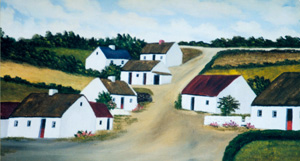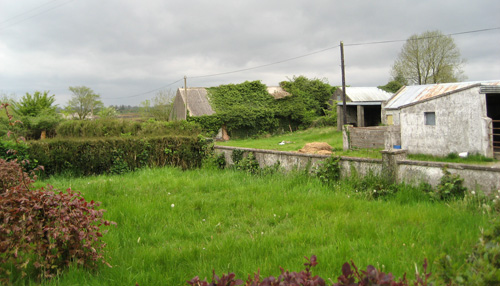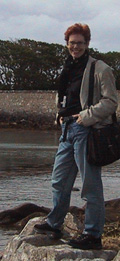The Family Land
 In
the end they had his and her farms, my great-grandparents did.
No one is quite sure of the legal details, but somehow M'ma got her
hands on property at Cooloo and moved to the new "home-house" about
12 km. to the south, while D'da continued to work the farm
at Ballaghduff. Who knows what family dynamics swirled around this
transaction, but from an economic perspective, it was good business.
In the long run, both elder sons were able to become landholders.
Everyone pitched in to make both properties successful. Grandson
Mick Dunne, the current patriarch of Cooloo, remembers the two farms
sharing a horse. He would ride the horse to Ballaghduff; they would
plow the land there; then they would ride the horse back to plow Cooloo.
In
the end they had his and her farms, my great-grandparents did.
No one is quite sure of the legal details, but somehow M'ma got her
hands on property at Cooloo and moved to the new "home-house" about
12 km. to the south, while D'da continued to work the farm
at Ballaghduff. Who knows what family dynamics swirled around this
transaction, but from an economic perspective, it was good business.
In the long run, both elder sons were able to become landholders.
Everyone pitched in to make both properties successful. Grandson
Mick Dunne, the current patriarch of Cooloo, remembers the two farms
sharing a horse. He would ride the horse to Ballaghduff; they would
plow the land there; then they would ride the horse back to plow Cooloo.
Now that I've tramped across some of my ancestral land, I'm fascinated by how they lived, how it all worked.
In 2000, 18 residents of Kilkerrin (County Galway) participated in a Certificate Course in Local History and produced a book called "A Place of Genius and Gentility: Insights into Our Past." My cousin Josephine Collins was on the Editorial Board and contributed a chapter on "The Townland of Ballaghduff."

In 1856, Griffith's Valuation [3] listed 8 parcels worked by about 25 families, with the two largest areas run by 8 and 9 families each. By my grandmother's day, the property at Ballaghduff was worked by the families who lived in two clusters a few hundred feet apart, with about 12 thatch-roofed houses. About a third of the 471 acres was bog — considered worthless at the time. The rest ranged from good to poor as farmland goes.
The texture of the land is as mesmerizing as Ireland's rocky coasts. But it would be a mistake to romanticize it. M'ma and D'da supplemented their income by sending their sons to work in the English coal mines in the winter. Michael broke his hip in the mines. And yet...
Katie was one of the daughters to leave for St Louis. For 7 years she was a lady's maid and had a grand time, including travels to Florida. But she came back to Ballaghduff, married, and raised 7 kids in one of those tiny houses in the painting above. The pull of place.
Our cousin Philomena Kelly (1931-2000) became a school teacher in the area and described the land to Josephine in the following interview [4]:
Fr. Glynn... re-named Ballaghduff Tír na nÓg [Land of Eternal Youth]... We could field a team for a hurling match in Wall's field or a football team for a game in the lanes in Milltown... Our social life lacked nothing. A princeam (from the old English word "prinkum," meaning a caper or house dance) was organised in a few hours and these took place regularly. Our musicians were locals who played fiddle, tin whistles and in later years, the accordion. Songs were sung, poems recited and stories of other days were told. Gaelic words were used frequently and traces of the Gaelic era are found in the names of fields and gardens. In our village, Baile Thoir (east), households had narrow strips of land called "gits" probably from the Irish word giota, a small portion.
The beairnín or bearnán rua (translated as little gap or red gap) was a name given to fields in a part of the village where the grass took on a reddish hue in the autumn. Then there was Coiléir an Áirne (quarry of the sloe), Moínín Árd (high meadow) and Moín Guail or gcúl (bog of the hard, black turf or back bog). This word moín was pronounced "moon" which is the western Gaeltacht pronunciation. Gort a' bhealaigh was another field name. It got its name from the path to school through the fields. Between Ballaghduff and Clooncunore are the askeys, from the Irish, eascaí, low-lying land by the river. One field was called the flax field, as flax was grown there. The "tow" was the rough or discarded flax. Men wove a plait of this to repair the flail. Linen sheets, towels and tablecloths were in every house. In the words of the poet, Wordsworth, "Bliss it was in that dawn to be alive. But to be young was very heaven."
"Tír na nÓg ... considered a place beyond the edges of the map... It could be reached by either an arduous voyage or an invitation from one of its fairy residents." Hard not to think we were there.
5.29.07 (rev. 5.30.07, 5.26.16)
NOTES
[2] Throughout the 19th century Irish peasants rented from landlords, in my family's case from the D'Arcys. Early 20th century land reform finally allowed tenants to purchase. Then the Congested Districts Board awarded land to families as a way of fending off Home Rule. In 1901 there were only 3 families in Cooloo, so property was opened up there.
[3] The Tenement Act of 1842, now known as Griffith's Valuation, required an evaluation of every parcel of land for productivity. In the absence of census data, it's a useful source about info about communities.
[4] Published in "A Place of Genius and Gentility: Insights into Our Past." © Oidhreacht Chill Choirí, 2006. Published with private local funding.
IMAGE: Oil painting of half the houses in Ballaghduff, by M. Brennan (1973), from an earlier sketch by Philomena Kelly.
PHOTO: Ballaghduff today, on the gently modernized property of the late Paddy Kilmartin.

